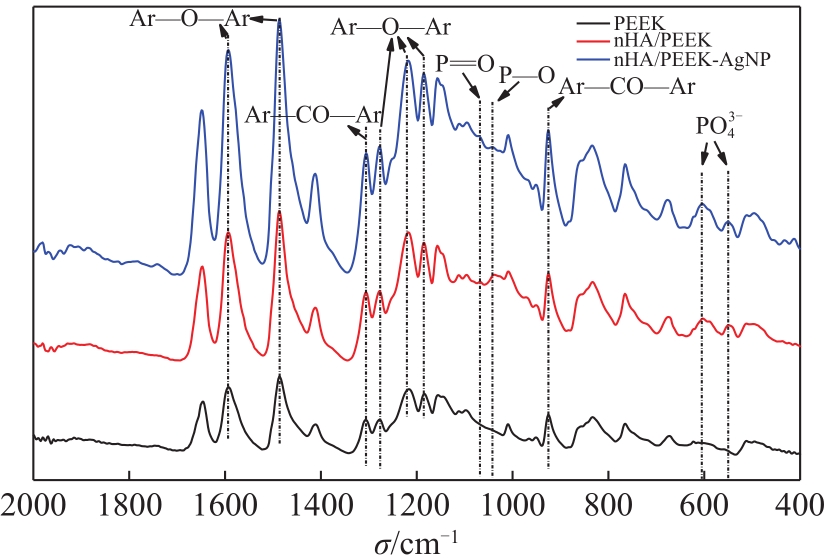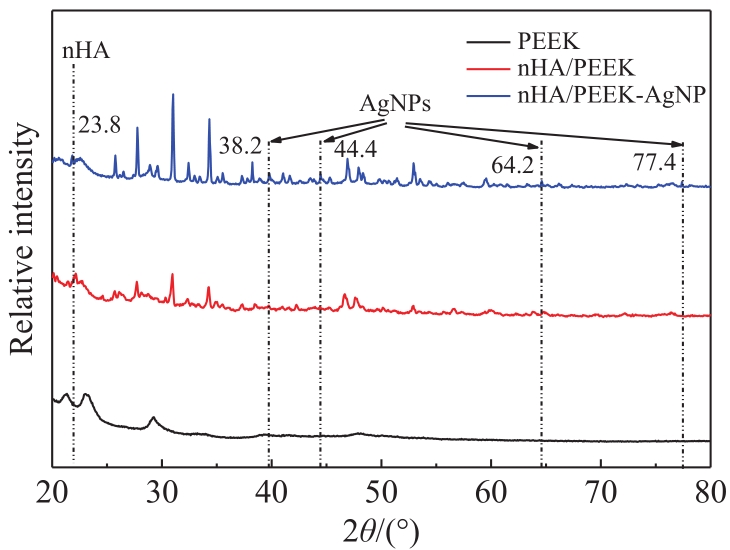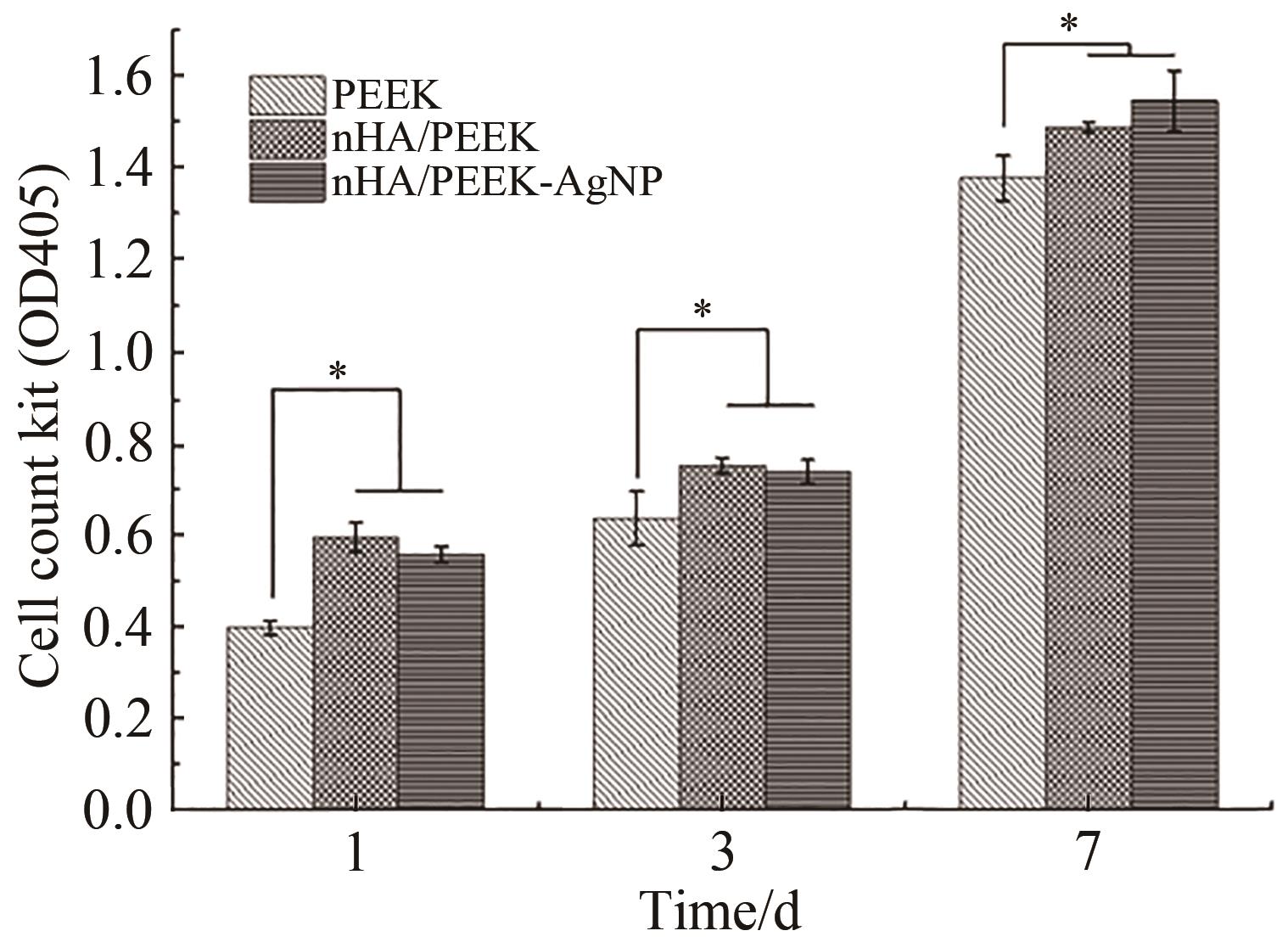
Chinese Journal of Applied Chemistry ›› 2023, Vol. 40 ›› Issue (4): 536-545.DOI: 10.19894/j.issn.1000-0518.220253
• Full Papers • Previous Articles Next Articles
Preparation and Properties of 3D Printed nHA/PEEK-AgNPs Composite Porous Scaffolds
Yu-Jie MA1, Ying-Xin ZHANG2, Huan-Yan DAI1, Zhi-Min XU1, Bing HAN1( )
)
- 1.Department of Oral and Maxillofacial Surgery II,Stomatological Hospital of Jilin University,Changchun 130021,China
2.Department of Oral Emergency,Stomatological Hospital of Jilin University,Changchun 130021,China
-
Received:2022-07-26Accepted:2023-02-22Published:2023-04-01Online:2023-04-17 -
Contact:Bing HAN -
About author:hbing@jlu.edu.cn
-
Supported by:the International Science and Technology Cooperation Project of Jilin Provincial Science and Technology Department(20190701035GH);the Industrial Technology and Research Project of Jilin Provincial Development and Reform Commission(2019C051-11)
CLC Number:
Cite this article
Yu-Jie MA, Ying-Xin ZHANG, Huan-Yan DAI, Zhi-Min XU, Bing HAN. Preparation and Properties of 3D Printed nHA/PEEK-AgNPs Composite Porous Scaffolds[J]. Chinese Journal of Applied Chemistry, 2023, 40(4): 536-545.
share this article
Add to citation manager EndNote|Ris|BibTeX
URL: http://yyhx.ciac.jl.cn/EN/10.19894/j.issn.1000-0518.220253
| Gene | Forward primer sequence (5′-3′) | Reverse primer sequence (3′-5′) |
|---|---|---|
| GAPDH | AACTTTGGCATTGTGGAAGG | ACACATTGGGGGTAGGAACA |
| Runx2 | GCCGGGAATGATGAGAACTA | GGACCGTCCACTGTCACTTT |
| Collagen1 | CACAGAGGTTTCAGTGGTTTGG | GCACCAGTAGCACCATCATTTC |
Table 1 Primer sequences
| Gene | Forward primer sequence (5′-3′) | Reverse primer sequence (3′-5′) |
|---|---|---|
| GAPDH | AACTTTGGCATTGTGGAAGG | ACACATTGGGGGTAGGAACA |
| Runx2 | GCCGGGAATGATGAGAACTA | GGACCGTCCACTGTCACTTT |
| Collagen1 | CACAGAGGTTTCAGTGGTTTGG | GCACCAGTAGCACCATCATTTC |
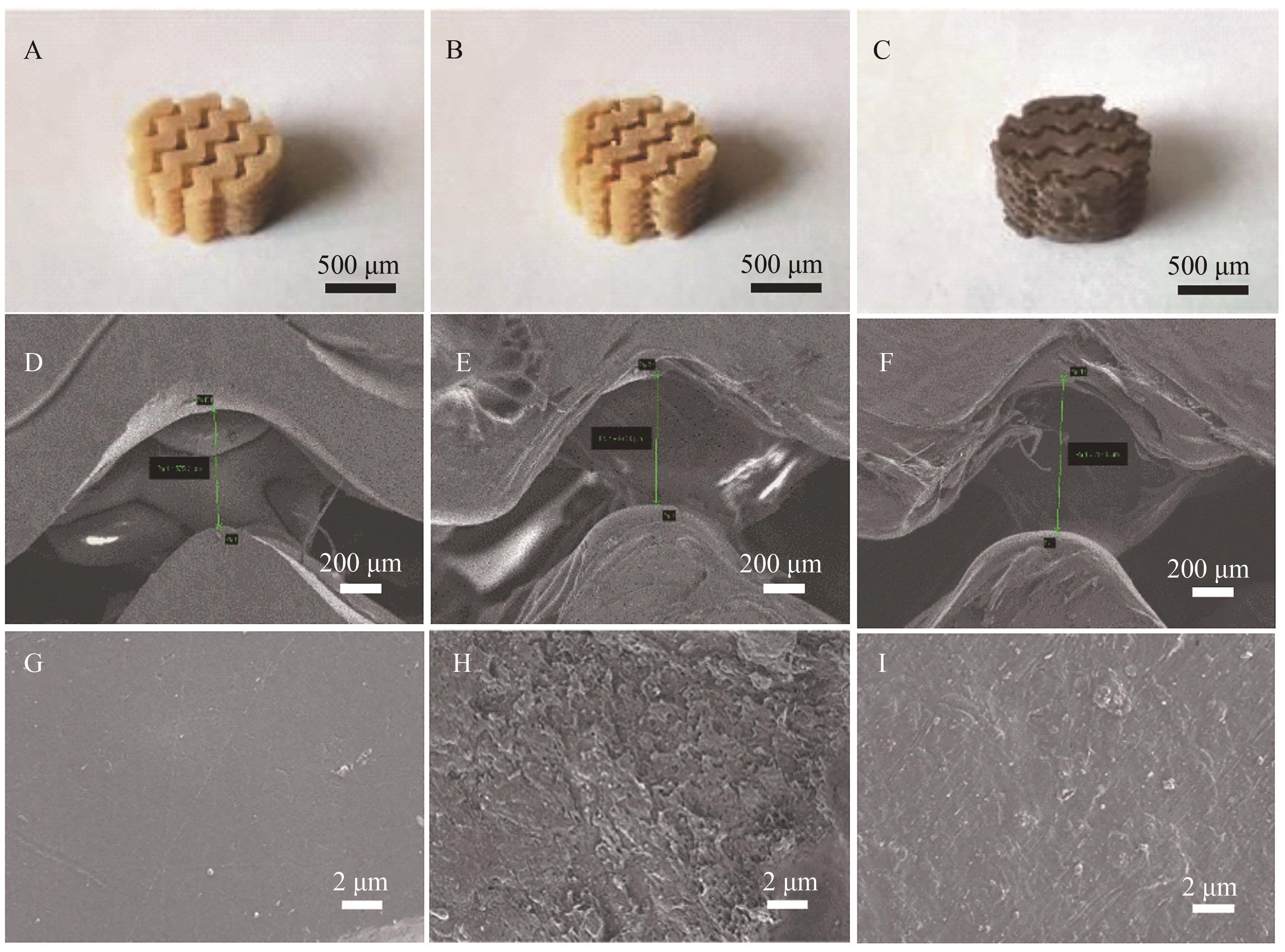
Fig.1 Appearance of material (A) PEEK, (B) nHA/PEEK, (C) nHA/ PEEK-AgNPs, and ESEM pictures of the microstructure and surface morphology of the material; (D) PEEK, (E) nHA/PEEK and (F) nHA/ PEEK-AgNPs were low magnification images; (G) PEEK, (H) nHA/PEEK and (I) nHA/ PEEK-AgNPs are high magnification images
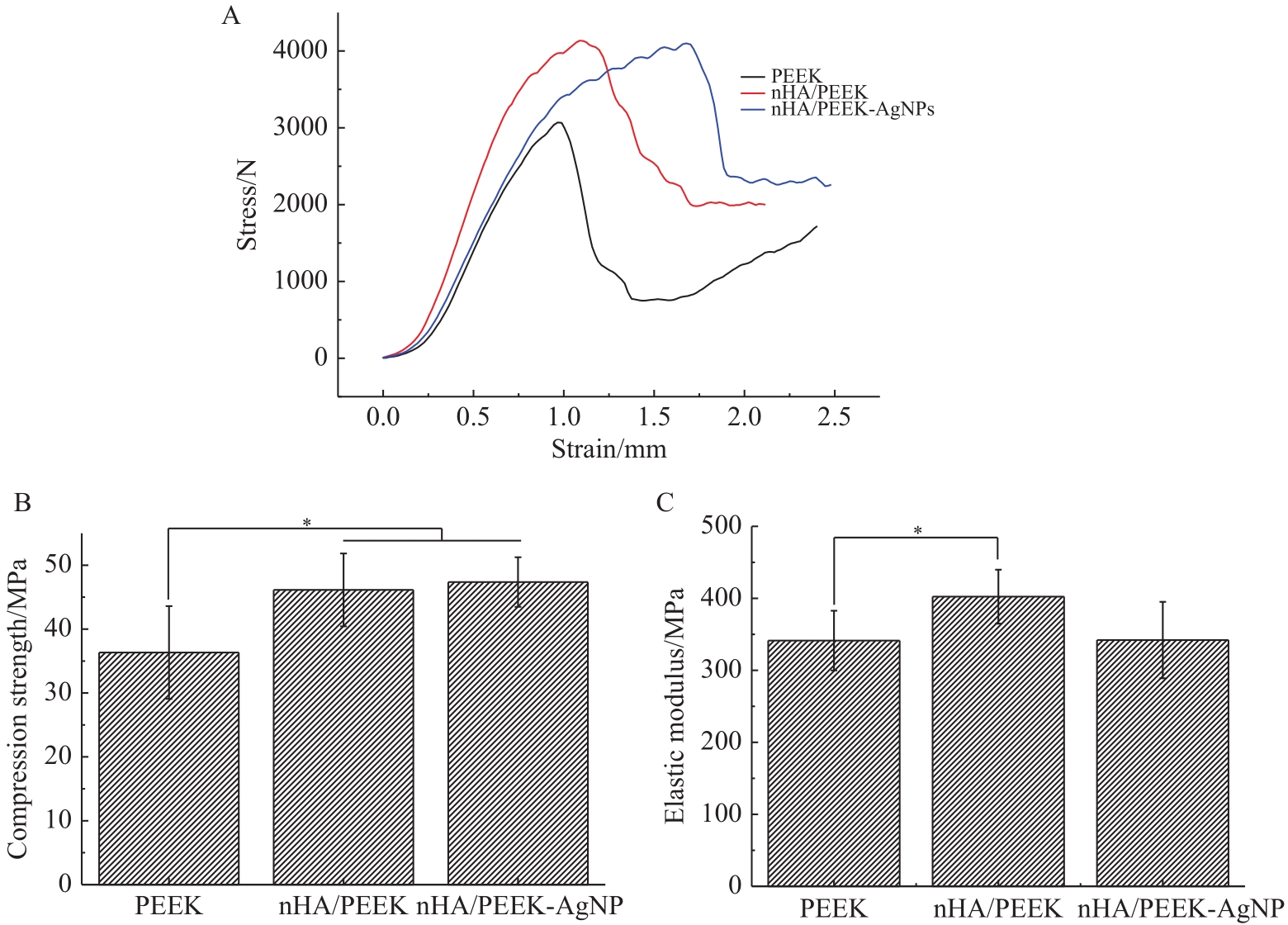
Fig.4 Stress-strain curves (A) and comparison of maximum compressive strength (B) and maximum elastic modulus (C) of three groups of scaffold materials (PEEK, nHA/PEEK and nHA/PEEK-AgNPs). n=3, *P<0.05
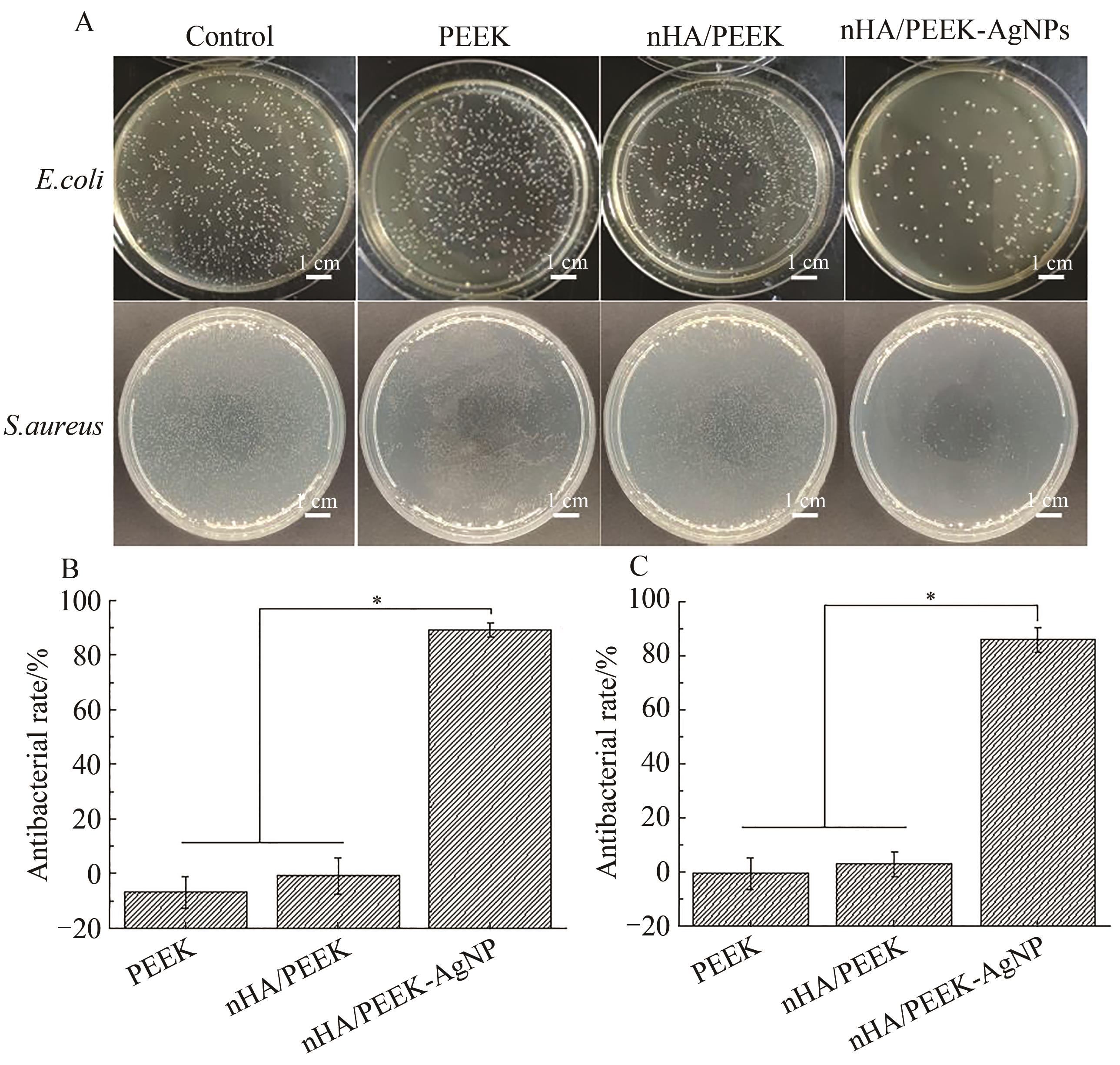
Fig.6 The bacteriostasis rate of scaffold materials (PEEK, nHA/PEEK and nHA/PEEK-AgNPs) against Escherichia coli (B) and Staphylococcus aureus (C). n=3, *P<0.05
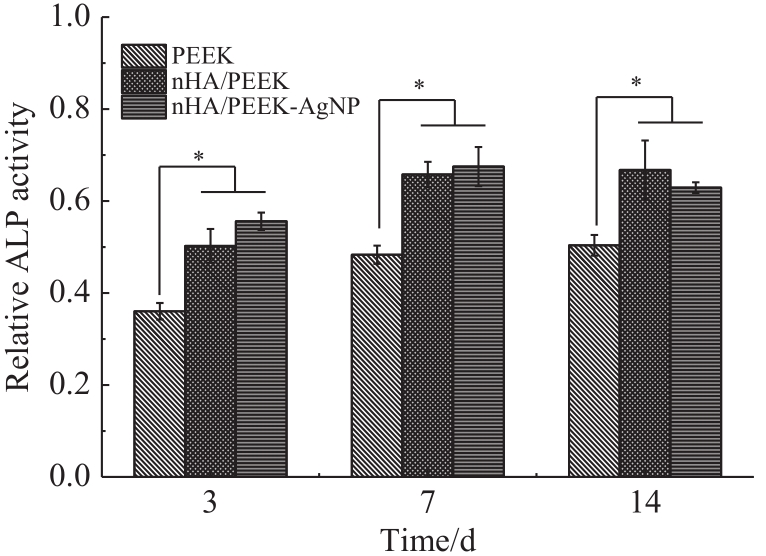
Fig.9 Relative alkaline phosphatase activity of MC-3T3-E1 cells on PEEK, nHA/PEEK and nHA/PEEK-AgNPs at different time points (3, 7 and 14 d). n=3, *P<0.05
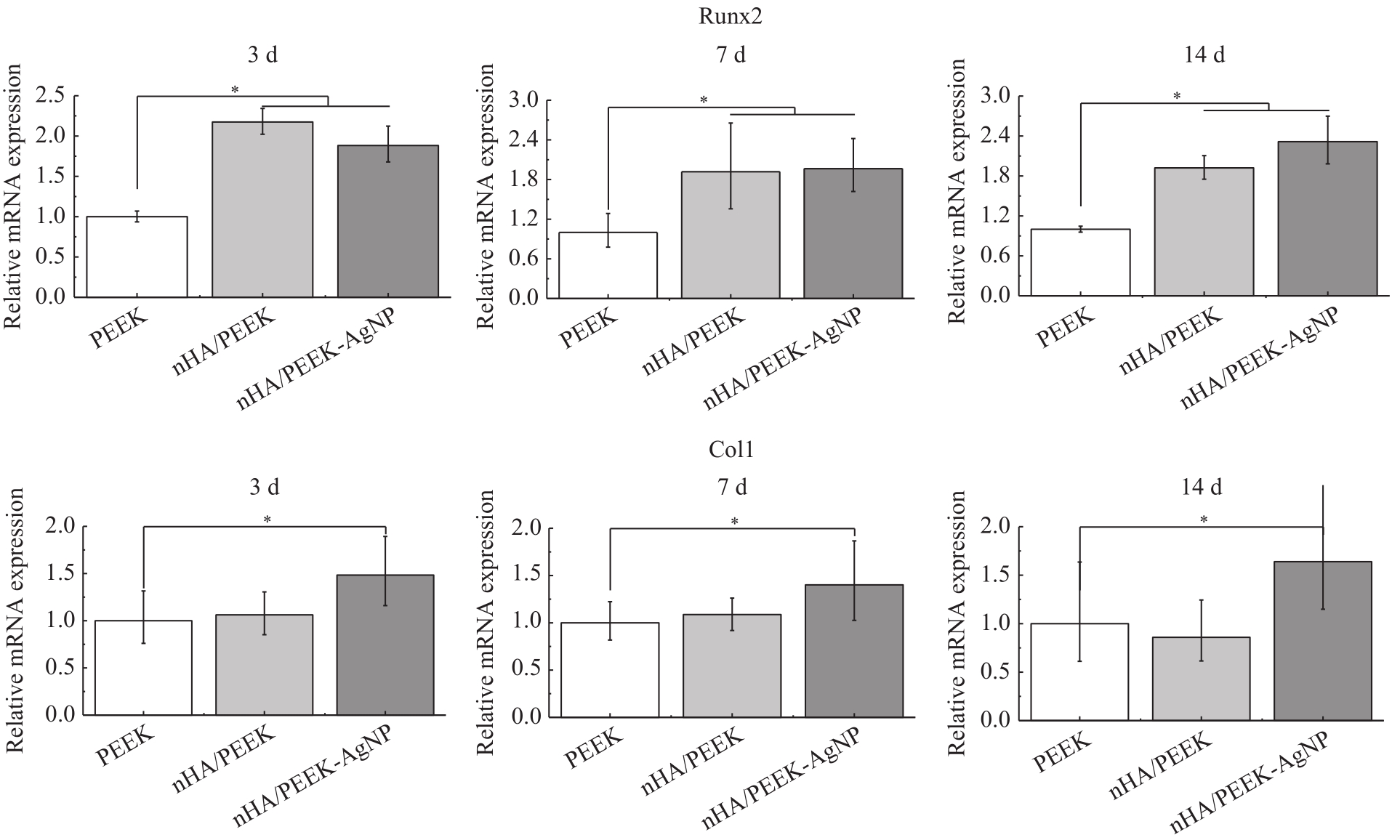
Fig.10 Expression of osteogenic genes (Runx2, Col1) in MC-3T3-E1 cells on materials (PEEK, nHA/PEEK and nHA/PEEK-AgNPs) at different time points (3, 7 and 14 d). n=3, *P<0.05
| 1 | BEHR M, ZEMAN F, PASSAUER T, et al. Clinical performance of cast clasp-retained removable partial dentures: a retrospective study[J]. Int J Prosthodontics, 2012, 25(2): 138-144. |
| 2 | TANNOUS F, STEINER M, SHAHIN R, et al. Retentive forces and fatigue resistance of thermoplastic resin clasps[J]. Dent Mater, 2012, 28(3): 273-278. |
| 3 | BENSO B, KOVALIK A C, JORGE J H, et al. Failures in the rehabilitation treatment with removable partial dentures[J]. Acta Odon-tol Scand, 2013, 71(6): 1351-1355. |
| 4 | DONOVAN T E, CHO G C. Esthetic considerations with removable partial dentures[J]. J Calif Dent Assoc, 2003, 31(7): 551-557. |
| 5 | ZHAO D, ZHU T, LIA J, et al. Poly(lactic-co-glycolic acid)-based composite bone-substitute materials[J]. Bioact Mater, 2021, 6: 346-360. |
| 6 | ZHU T, JIANG M, ZHANG M, et al. Biofunctionalized composite scaffold to potentiate osteoconduction, angiogenesis, and favorable metabolic microenvironment for osteonecrosis therapy[J]. Bioact Mater, 2022, 9: 446-460. |
| 7 | NOROTTE G, BARRIOS C. Clinical and radiological outcomes after stand-alone ALIF for single L5-S1 degenerative discopathy using a PEEK cage filled with hydroxyapatite nanoparticles without bone graft[J]. Clin Neurol Neurosurg, 2018, 168: 24-29. |
| 8 | 白石柱, 张生睿, 钟声, 等. 3D打印及其在口腔医学中的应用(二)—常用成型工艺[J]. 实用口腔医学杂志, 2022, 38(2): 275-280. |
| BAI S Z, ZHANG S R, ZHONG S, et al. 3D printing and its application in stomatology (ii)-common molding process[J]. J Pract Stomatol, 2022, 38(2): 275-280. | |
| 9 | ZHU P, WENG L, ZHANG X R, et al. Graphene@poly(dopamine)-Ag core-shell nanoplatelets as fillers to enhance the dielectric performance of polymer composites[J]. J Mater Sci, 2020, 55: 7665-7679. |
| 10 | MA R, GUO D. Evaluating the bioactivity of a hydroxyapatite-incorporated polyetheretherketone biocomposite[J]. J Orthop Surg Res, 2019, 14(32): DOI: 10.1186/s13018-019-1069-1. |
| 11 | GAO C, WANG Z, JIAO Z X, et al. Enhancing antibacterial capability and osseointegration of polyetheretherketone (PEEK) implants by dual-functional surface modification[J]. Mater Design, 2021, 205: 109733. |
| 12 | 赵丙辉, 李沅, 李文娇. 3D打印技术制备骨科植入材料聚醚醚酮的力学性能研究及氨基改性对材料成骨性能的影响[J]. 中国医疗器械信息, 2021, 27(13): 10-12, 74. |
| ZHAO B H, LI Y, LI W J. Mechanical properties of polyether-ether-ketone prepared by 3D printing technology and the effect of amino modification on the osteogenic properties of orthopedic implant materials[J]. China Med Dev Inf, 2021, 27(13): 10-12, 74. | |
| 13 | LEE J H, JANG H L, LEE K M, et al. In vitro and in vivo evaluation of the bioactivity of hydroxyapatite-coated polyetheretherketone biocomposites created by cold spray technology[J]. Acta Biomater, 2013, 9(4): 6177-6187. |
| 14 | GAO C, WANG Y, HAN F, et al. Antibacterial activity and osseointegration of silver-coated poly(ether-ether-ketone) prepared using the polydopamine-assisted deposition technique[J]. J Mater Chem B, 2017, 5(47): 9326-9336. |
| 15 | 林柏仲, 赵丽, 王宏伟, 等. 生物黏合水凝胶研究进展[J]. 功能高分子学报, 2020, 33(2): 125-140. |
| LIN B Z, ZHAO L, WANG H W, et al. Progress in bioadhesive hydrogels[J]. J Funct Polym, 2020, 33(2): 125-140. | |
| 16 | 赵常利, 秦明高, 窦晓秋, 等. 纳米颗粒增强的手性超分子水凝胶成骨性能[J]. 应用化学, 2022, 39(1): 177-187. |
| ZHAO C L, QIN M G, DOU X Q, et al. High mechanical stability and osteogenesis of chiral supramolecular hydrogel induced by inorganic nanoparticles[J]. Chin J Appl Chem, 2022, 39(1): 177-187. |
| [1] | Li-Juan YAN, Tian-He GAO, Dong-Jian SHI, Ming-Qing CHEN. Preparation and Properties of Eugenol/Modified Polyvinyl Alcohol Antibacterial Composite Films [J]. Chinese Journal of Applied Chemistry, 2023, 40(4): 527-535. |
| [2] | Yu-Zhu CHEN, Si-Si LIU, Meng-Meng ZHANG, Xiang-De LIN, Dong-Dong ZENG. Polyurethane Dressing Based on Antibacterial Chitosan/Carboxymethyl Cellulose Composite Drug Coating [J]. Chinese Journal of Applied Chemistry, 2023, 40(2): 252-260. |
| [3] | Jia-He WANG, Da-Yong LIU, Wei LIU, Lin WANG, Biao DONG. Research Progress on Photocatalytic Antibacterial Application of TiO2 Nano Materials [J]. Chinese Journal of Applied Chemistry, 2022, 39(4): 629-646. |
| [4] | Xiao-Ming XIE, Jia-Qi ZHANG. Hydrogen Bond Interaction Driven Procyanidine Assembly into Underwater Adhesive with Antibacterial Activity [J]. Chinese Journal of Applied Chemistry, 2022, 39(10): 1533-1542. |
| [5] | ZHAO Chang-Li, QIN Ming-Gao, DOU Xiao-Qiu, FENG Chuan-Liang. High Mechanical Stability and Osteogenesis of Chiral Supramolecular Hydrogel Induced by Inorganic Nanoparticles [J]. Chinese Journal of Applied Chemistry, 2022, 39(1): 177-187. |
| [6] | YANG Jia-Qiang,WU Xue-Jiao, ZHOU Xu-Rong, DENG Ling, YANG Hong. Synthesis and Antibacterial Activities of Osthole Ester Derivatives [J]. Chinese Journal of Applied Chemistry, 2021, 38(8): 917-922. |
| [7] | ZHAO Yue, MENG Xiang-Qin, YAN Xi-Yun, FAN Ke-Long. Nanozyme: A New Type of Biosafety Material [J]. Chinese Journal of Applied Chemistry, 2021, 38(5): 524-545. |
| [8] | LIU Hui, LIU Xiao, CAO Yuan-Qiao, LIU Ming, LIU Ya-Dong, HAN Miao-Miao, JI Sheng-Xiang. Research Progress on Amino Acid-Based Antimicrobial Polymers [J]. Chinese Journal of Applied Chemistry, 2021, 38(5): 559-571. |
| [9] | LIN Qiu-Peng, ZHANG Zhu-Ying, SHI Dong-Jian, PEI Ze-Jun, CHEN Ming-Qing, NI Zhong-Bin. Preparation and Properties of Sustained Release Chitosan/Chlorhexidine Acetate Composite Microspheres [J]. Chinese Journal of Applied Chemistry, 2021, 38(12): 1599-1611. |
| [10] | Sha-Man LUO, Hao-Zhe SUN, Shi-Qiang YAN, Hui HUANG, Wei-Jia ZHANG, Jia WEI, Yan-Lei YU. Cell Biocompatibility of Photodeformable Azobenzene⁃containing Liquid Crystal Polymers [J]. Chinese Journal of Applied Chemistry, 2021, 38(10): 1371-1381. |
| [11] | ZHOU Chao, SHENG Cheng-Ju, WEN Lin-Lin. Preparation of Imidazolium Salt-based Poly(ionic liquids) Antibacterial Agent and Its Application in Hydrogel Dressing [J]. Chinese Journal of Applied Chemistry, 2021, 38(1): 51-59. |
| [12] | XING Yayan, SHI Yuzhe, DENG Shixian, ZHAO Baihan, LIU Zhiguo. Preparation and Application of Catechin-Silver Nanocomposites [J]. Chinese Journal of Applied Chemistry, 2020, 37(9): 1062-1068. |
| [13] | SUN Zhenlong, YAN Shunjie, ZHOU Rongtao, ZHANG Zhenyan, OUYANG Zhaofei, ZHU Xuezhen, YIN Jinghua. Recent Progress in the Development of Smart Coatings Based on Antimicrobial Peptides [J]. Chinese Journal of Applied Chemistry, 2020, 37(8): 865-876. |
| [14] | YANG Jin,MA Qiseng,ZHONG Ying,ZHU Longbao,GE Fei,TAO Yugui,SONG Ping. Solid-Phase Synthesis of Cyclohexapeptide Thermoactinoamide A and Its Antibacterial Activity [J]. Chinese Journal of Applied Chemistry, 2019, 36(6): 677-682. |
| [15] | LING Huiping,CHEN Xiaoqing,XIE Shengnan,CHEN Yuejian,SHE Zhigang,LIN Yongcheng,TAO Yiwen. Dihydroisocoumarin Compounds from Endophytic Fungi of Rhizophora apiculata and Its Antibacterial Activity [J]. Chinese Journal of Applied Chemistry, 2018, 35(6): 708-713. |
| Viewed | ||||||
|
Full text |
|
|||||
|
Abstract |
|
|||||
